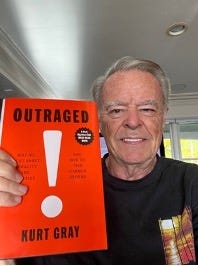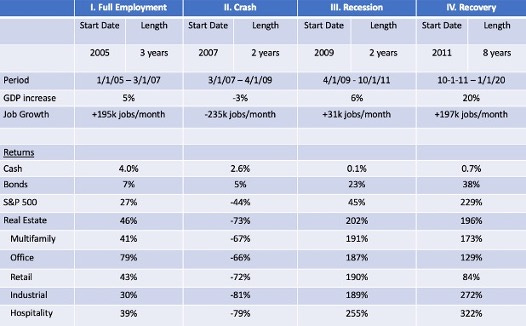Tribal Warfare + Outrage = Credit Crisis?
Disruptive political tribal warfare threatens to derail the economy. Are you ready?
Summary: Last week I reminded you that excess of fear and anger in the world is going to last a long, long time. Fear and anger drive people into the imagined-safety of their own tribes where they line up behind strongman leaders and blame their problems on the other tribe. The result is tribal warfare, radical change, and unstable economies and financial markets.1 And I advised you that when headline events make you scared or excited you should step away from your portfolio, as I do, and walk around the block. Never allow emotions like FOMO and FONGO trick you into a bad investment decision.2
Yesterday I got to walk around the block 6 times when stock markets tanked. Or, as I prefer to think about it, when the market put all of the best companies on sale. But don’t buy them just yet. As I explain below, conditions like these can push financial markets into the state of temporary paralysis we call credit crisis. In this post, I show you an analysis of the 2008 crisis and explain why more liquidity and less leverage can protect your capital.
What to Do When We’re All Outraged
Before I launch into credit market failures and what to do about them I want to ask you to read a book. I had the good fortune to learn to read very fast at a young age, so I don’t read books; I devour them. As you know, I have been fascinated by the link between pandemics, human behavior, and system science, so I read more than a hundred books on epidemiology, history, evolutionary biology, sociobiology, and social psychology over the past year. I learned a ton.
I read a book today that I want to recommend to you, Outraged, by Kurt Gray, a Professor of Psychology and Neuroscience at UNC. It explains that evolutionary history has hard-wired our brains to protect our families from predators by collapsing into defensive tribes when we feel threatened or vulnerable to harm. That is what has happened to politics, in the U.S. and everywhere else, over the past 5 years. Both sides feel that “we” are victims and “they” are trying to harm us. We have stopped communicating across tribes and get all our information within our own echo chambers—one team only listens to MSNBC, the other only listens to Fox News. And we have developed false beliefs about what the other tribe is thinking, feeling, or doing.3 Gray’s research finds that each team thinks of the other team as less intelligent than their own and that each team thinks that the other side lacks a basic sense of right and wrong. The result is certain conflict.4
Without giving away the spoiler about what Gray says we can do to unwind the situation I will give you my short pitch about where we are today. IMHO, we are the luckiest people in the history of the world with both more freedom and a higher standard of living than anyone who has ever lived and than most of the people alive on earth today. Not too long ago, we all knew we were on the same team, and we all knew that we were on the winning team. But, somehow, we forgot all of We broke the country.
We have to fix this thing for our kids and grandkids. And we need to do it now. To do that, we’re going to have to stop blaming each other, stop referring to each other as lefties or righties or socialists or fascists, lose the “-isms”, and learn how to work together again. As Kissinger reminded us, “even paranoid people have enemies.” There actually are people out there who would like to do us harm. They love it when we are mired in tribal warfare. Think about it.
More Liquidity/Less Leverage
Adequate liquidity and low leverage are paramount during an extended period of fear and turbulence.
Tribal warfare, itself, is a source of systemic risk. Network theory teaches us that the associated reduction in trust increases the likelihood of extreme outcomes. It also increases the fragility of financial and communication networks, raising the chances that a large and highly connected information network abruptly fractures into a collection of smaller networks that no longer communicate with each other, much like politics has disrupted communication between friends and in families.
In network theory, these events are known as cascading network failures.5 In economics, we call them credit crises. They occur when buyers and sellers of financial assets no longer trust that the prices they are quoted by highly connected market participants accurately reflect underlying scarcity and no longer believe that liquidity will be there when they need it. In a credit crisis, a market abruptly switches from price-clearing to nonprice-rationing. The most memorable recent example was the 2008 Subprime debt crisis. The poster child was Lehman Brothers.
In the early days of COVID, I posted an analysis of the 2008 credit crunch. In my analysis, the sudden collapse of credit availability we call a credit crisis is a phase transition between a state of normal, price-clearing equilibrium and a temporary state of nonprice credit caused by a cascading network failure. In 2008, that phase transition is called the Lehman Moment when we all had the same look on our face as Wiley Coyote when he realized he had run past the edge of the cliff and solid ground was a long way down.
I prepared a graphic representation, which I have copied above, of what happens when a sudden phase transition throws the economy into an alternative state where businesses have to get by without access to working capital, how the broken network recovers back to normal over time, and how different asset classes perform along the way. I won’t give you the full explanation here but invite you to read it here.
The table above shows the returns on different asset classes—cash, stocks, bonds, and 5 categories of commercial real estate--for each phase of the credit crunch. The cumulative returns for each asset class are shown above. Read the full analysis here.
The lesson is clear. Cash and bonds are the only safe place to be during the crash phase of a credit crisis. To the extent that you hold cash, you will have underperformed relative to everything else during the prior Full Employment phase. But you will have preserved your capital during the crash and could have used the cash to buy top quality stocks and bonds at deep discounts and ride the escalator all the way back to the top for huge returns over the ensuing decade.
So where are we now? No one is capable of precisely predicting when the next phase transition is going to happen. But there are plenty of signs that we are ripe for one. We have enjoyed high returns for a long time. There are huge fixed-income and commercial real estate losses on regional bank balance sheets that will one day have to be written down to reality. As a result, banks have completely shut down business lending. Banks have made minus $42 billion of net new loans to their business customers since January 2023, i.e., they have collected $42 billion more in loan principal repayments from business customers than they have lent tobusiness customers over the past 2 years.
This puts the radical headlines coming out of Washington in a new light. Every announcement of a big program cut, government employee furlough, or suspension of outlays makes somebody clench up, reduce their purchases, and delay hiring and capital spending projects. All of these things push output lower. They reduce somebody’s income and raise questions about that somebody’s credit worthiness and the value of collateral behind outstanding loans. That’s why people are talking about recession again today.
To be clear, my point has nothing to do with whether any program should be cut or expanded. It is simply that if you try to do too much, too fast, in a cloud of uncertainty, you run the risk of eroding trust enough to push the financial network into nonprice rationing, creating an ugly downdraft in asset prices, and an interruption of economic activity. That’s something neither tribe wants to happen.
So, what can an investor do to protect capital from the risk of a credit crisis so you have sufficient purchasing power to be able to take advantage of a sharp drop in stock prices. In my case, I have decided to hold double the amount of cash that I would hold in a more normal time. For me, that number is 30% of total assets. And I am holding the cash in Treasury bills, currently paying 4.3%, so I have quick liquidity when I need it. I am not yet ready to deploy all of that cash, but that time may not be far away.
Dr. John
References
Andelman, D. A. (2008). A Shattered Peace. New York: John Wiley & Sons.
Andelman, D. A. (2021). A Red Line in the Sand. New York: Pegasus Books.
Bak, P. (1996). How Nature Works: The Science of Self-Organized Criticality. New York: Springer Verlag.
Gray, K. (2025). Outraged: Why pe fight about morality and politics and how to find common ground. New York: Pantheon Books.
Haidt, J. (2012). The Righteous Mind. New York: Vintage.
Kandel, E. (2006). In Search of Memory. New York: Norton.
McNeill, W. H. (1977). Plagues and Peoples. New York: Doubleday.
McNeill’s classic Plagues and Peoples (1977) is the best background material to read on the historical aftermaths of plagues and pandemics. I highly recommend it.
FOMO (Fear Of Missing Out) is the fear that someone else is getting something you are not. FONGO (Fear Of Not Getting Out) the fear that someone else is going to get out before you do and leave you holding a bag of worthless stocks. I learned about both of them the hard, expensive way.
Gray has done research that shows both sides think of political opponents as stupid. “Research from my own lab finds that liberals and conservatives see each other as about half as smart as members of their own party.” (p. 18.)
For a second take of the social psychology research on why people fight over politics I can suggest Jonathan Haidt’s The Righteous Mind 2012).
The best explanation of a cascading network failure is in Bak’s How Nature Works (1996).









My anecdotal observation is: it's not just the banks and sophisticated investors that have already built their cash positions. imo there is an increased frequency of assertions in forums like SeekingAlpha, Motley Fool boards, substacks etc. from everyday retail investors (...like myself and my friends) holding 30+% in cash and cash equivalents, and "saving their dry powder" for a crash we all anticipate will occur soon.
The challenge that markets present to an individual Investor is that the collective wisdom of a market is always a step ahead of most of the market participants, at least in the short term. In other words, if we all think a crash is coming soon, then by definition/platitude it's almost certain that the market has already priced in that risk.
My assessment is that for those holding large cash positions, the actual biggest risk is NOT that the market unexpectedly takes off, and is NOT that the market crashes. The biggest risk is the market flatlines, (...potentially for years), causing opportunity cost from the time spent "treading water".
I have been wondering how much the rise in private and collateralized credit will help avoid a major credit crisis. Banks are lenders of first resort. It seems to me that a spike in short term floating rates is what will cause an economic and possibly financial crisis, however that might come about. If neither small business nor private equity can afford private credit, watch out!